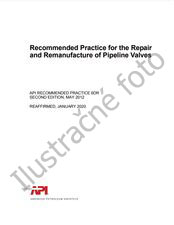Potrebujeme váš súhlas na využitie jednotlivých dát, aby sa vám okrem iného mohli ukazovať informácie týkajúce sa vašich záujmov. Súhlas udelíte kliknutím na tlačidlo „OK“.

API PUBL 959-ed.1982
Characterization Study of Temper Embrittlement of Chromium-Molybdenum Steels
NORMA vydaná dňa 1.1.1982
Informácie o norme:
Označenie normy: API PUBL 959-ed.1982
Dátum vydania normy: 1.1.1982
Kód tovaru: NS-1139919
Počet strán: 145
Približná hmotnosť: 466 g (1.03 libier)
Krajina: Americká technická norma
Kategória: Technické normy API
Anotácia textu normy API PUBL 959-ed.1982 :
API PUBL 959, 1982 Edition, 1982 - Characterization Study of Temper Embrittlement of Chromium-Molybdenum Steels
I. INTRODUCTION
In 1975 the API awarded a contract to Westinghouse R&D Center (WRDC) to evaluate the temper embrittlement characteristics of Cr-Mo pressure vessel steels. The steels are designated A387 in Part 4 of the ASTM Book of Standards. Most of the samples supplied were of Grade 22)2-1/4Cr - 1Mo) and a few samples of Grades 11 and 21 were also included (1-1/4Cr - 1/2Mo, 3Cr - 1Mo). The 64 samples received represented a large range of commercially produced steel including qualification welds in 1-in. and 6-in. plate, large nozzle cut-outs and randonly shaped pieces of forging and plate material. These materials had received heat treatment typical of hydro-treater reactor fabrication. The samples were typified by a simple code as follows:
FOR Forging
PLA Plate
SAW Submerged Arc Weld
ESW Electroslag Weld
SMA Shielded Metal Arc Weld
1 1-1/4Cr - 1/2Mo
2 2-1/4Cr - 1Mo
3 3Cr - 1Mo
The objective of this program was to characterize typical commercial reactors steels and weldments in terms of toughness due to long time service at elevated temperature. It is important to note that these materials were typical of commercial production and fabrication up to about 1975, and are not representative of the plate, forgings and weld metal, having low temper embrittlement susceptibility available today [1]. Phase I of the project included the metallography and grain size, the tensile properties and the Rockwell Hardnesses, the analytical chemitries including the tramp elements, the heat treatments and Charpy impact test data. The latter yielded the Fracture Appearance Transition Temperatures (FATT) and the 40 ft-lb Transition Temperatures (40 ft-lb TT) for the steels in the unembrittled and step-cooled embrittled condition. The terms ?FATT and ?T(40) refer to the change in FATT and the 40 ft-lb TT due to temper embrittlement.
The main part of Phase II was the characterization of the isothermal embrittlement of 25 steels assessed in Phase I. Five isothermal embrittlement temperatures were chosen at 75°F intervals from 650° to 950°F. Tests to measure the amount of temper embrittlement were carried out after 1,000, 10,000 and 20,000 hours. A number of studies were also performed in this time. These were:
- 0 The effect of repeated de-embrittlement of the steel.
- 0 The effect of strength level and structure.
- 0 Auger analysis of grain boundaries of embrittled steels.
- 0 JIC measurements.
- 0 Effect of high pressure hydrogen on temper embrittlement.
- 0 Isothermal embrittlement of 1-1/4Cr and 3Cr steels.
By the end of 1976 the first phase of the program had been completed. At this juncture in the program a number of discrepancies, between the data generated at WRDC and other laboratories, were brought to light. These included the visual readings of the percentage of brittle fracture on the Charpy specimens, the conclusion that ?FATT was not always equal to ?T(40), absolute differences in the Charpy impact energy curves and the results of the analytical chemistries. In addition, it was found that in Phase I of the program WRDC had used a Charpy specimen orientation which was different than the one conventionally used by API.
As a consequence, a number of subsidiary experiments were intitiated to clarify the various issues. These included a comparative Charpy impact test study between Japan Steel Works (JSW) and WRDC and a comparative fracture surface evaluation study between Chicago Bridge and Iron (CB&I) and WRDC (see Appendix). At the same time, since the specimens for Phase II of the program were machined in the conventional API orientation, experiments designed to establish the relationship between the Phase I and Phase II orientations were carried out.
In addition, the API Task Group initiated a round robin comparative analysis of samples and also requested the National Bureau of Standards to establish a solid 2-1/4Cr - 1Mo Standard for spectrographic analysis. As a direct result of the API Task Group efforts, this standard designated SRM 1270, is now available for public purchase from NBS. The subsidiary experiments were carried out during Phase II of the project which was concluded in 1980. This paper reviews the primary results of the programs.



 Cookies
Cookies
